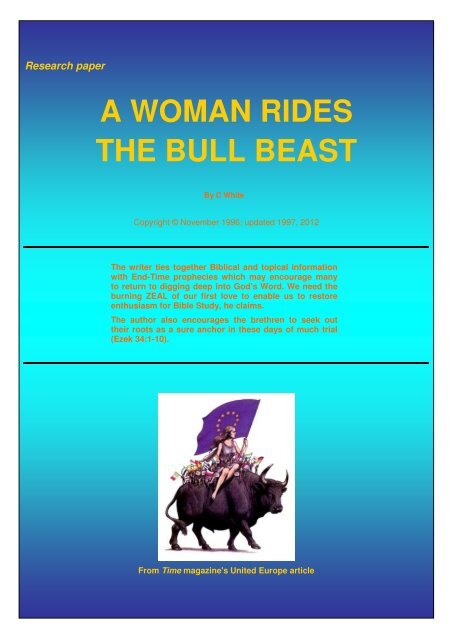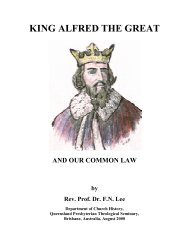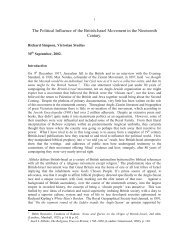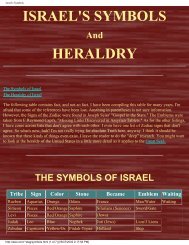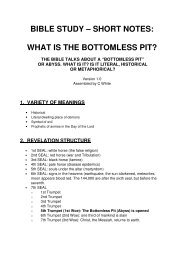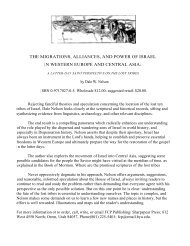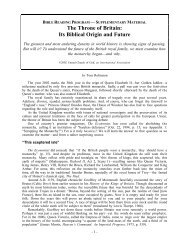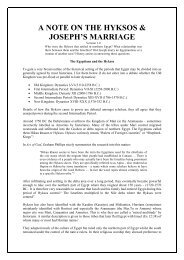A WOMAN RIDES THE BULL BEAST - Origin of Nations
A WOMAN RIDES THE BULL BEAST - Origin of Nations
A WOMAN RIDES THE BULL BEAST - Origin of Nations
Create successful ePaper yourself
Turn your PDF publications into a flip-book with our unique Google optimized e-Paper software.
Research paper<br />
A <strong>WOMAN</strong> <strong>RIDES</strong><br />
<strong>THE</strong> <strong>BULL</strong> <strong>BEAST</strong><br />
By C White<br />
Copyright © November 1996; updated 1997, 2012<br />
The writer ties together Biblical and topical information<br />
with End-Time prophecies which may encourage many<br />
to return to digging deep into God’s Word. We need the<br />
burning ZEAL <strong>of</strong> our first love to enable us to restore<br />
enthusiasm for Bible Study, he claims.<br />
The author also encourages the brethren to seek out<br />
their roots as a sure anchor in these days <strong>of</strong> much trial<br />
(Ezek 34:1-10).<br />
From Time magazine's United Europe article
A Woman Rides the Bull Beast<br />
Introductory Remarks<br />
The great God <strong>of</strong> the universe who created all that is, inspired the Bible in its entirety<br />
from Genesis to Revelation. In it are precious gems <strong>of</strong> truth laid deep inside for us to<br />
dig out. He has constructed a work, the Word <strong>of</strong> God, which is designed to exercise<br />
the human mind with the express purpose <strong>of</strong> ensuring that we inculcate within us His<br />
interesting and mighty mind.<br />
Let us dig deep into His precious Word and discover yet more <strong>of</strong> His truth. In the<br />
book <strong>of</strong> Proverbs we are told:<br />
“Yea, if thou criest after knowledge,<br />
And liftest up thy voice for understanding;<br />
If thou seekest her as silver,<br />
And searchest for her as for hid treasure;<br />
Then shalt thou understand the fear <strong>of</strong> the Lord,<br />
And find the knowledge <strong>of</strong> God” (Prov 2:3-5).<br />
“It is the glory <strong>of</strong> God to conceal a thing:<br />
But the honor <strong>of</strong> kings is to search out a matter”<br />
(Prov 25:2).<br />
History Research Projects<br />
GPO Box 864, Sydney, Australia 2001<br />
www.origin<strong>of</strong>nations.org<br />
No limitation is placed upon reproduction <strong>of</strong> this document except that it must be reproduced in its<br />
entirety without modification or deletions. The publisher's name and address, copyright notice and this<br />
message must be included. It may be freely distributed but must be distributed without charge to the<br />
recipient.<br />
2
A Woman Rides the Bull Beast<br />
Why Prophecy<br />
Detailed, accurate prophecy, is closely related to Christian living for the following<br />
reasons:<br />
• it keeps the bride excitedly anticipating the bridegroom (Matt 25:1-13);<br />
• it leads one to repentance, to God’s Law and to a close relationship with Him<br />
(this is the theme <strong>of</strong> the prophets and the greatest prophet <strong>of</strong> all, Jesus<br />
Christ);<br />
• if we understand it, we will be in a position to escape the terrors which will<br />
descend upon the earth. We are charged to watch (this includes watching<br />
world events, the Laodiceanic condition <strong>of</strong> the Church and our spiritual<br />
states) (Luke 21:36; Matt 24:42; 25:13);<br />
• as we are living in the Latter Days, it behoves us to know the signs <strong>of</strong> the<br />
times and how world events line up with prophecy to enable us to warn a sick<br />
and dying world (Ezek 3:17; 33:1-7; Jer 6:17, 27);<br />
• “Where there is no vision the people perish” (Prov 29:18). The RSV<br />
translates “vision” as “prophecy”. The Hebrew word “hazon” is translated<br />
similarly elsewhere (see IIChron 32:32; Dan 8:1; Ob 1). Should we neglect<br />
these futuristic warning words <strong>of</strong> God, we will perish (see ISam 3:1; Lam<br />
2:9);<br />
• prophecy is a major pro<strong>of</strong> <strong>of</strong> the Bible;<br />
• and prophecy, by its very nature, encourages us to want to dig deeper and<br />
deeper into God’s Word, to uncover its precious nuggets.<br />
The Apostle Peter wrote:<br />
“neither be barren nor unfruitful in the knowledge <strong>of</strong> our Lord Jesus Christ<br />
[Christ’s knowledge – the Word <strong>of</strong> God]. But he that lacketh these things is<br />
blind, and cannot see afar <strong>of</strong>f ...<br />
“We have also a more sure word <strong>of</strong> prophecy: whereunto ye do well that ye<br />
take heed, as unto a light that shineth in a dark place, until the day dawn,<br />
and the day star arise in your hearts” (IIPet 1:9, 19. See IICor 4:6)<br />
3
A Woman Rides the Bull Beast<br />
Strange Bulls<br />
With the above in mind, let us consider the bull symbolism in Scripture which replete<br />
with types – typological items, people, practices or creatures which portray spiritual<br />
counterparts or future events. This duality <strong>of</strong> Scripture takes digging and a figurative<br />
magnifying glass to find these wonderful and pleasurable treasures. It is not easy to<br />
dig deep into the Word <strong>of</strong> God – it takes some mental exercise and self-discipline.<br />
We find typological bulls sacrificed during the Feast <strong>of</strong> Tabernacles (Numbers 29:12-<br />
38) in reduced numbers each day, viz:<br />
Day 1 13<br />
Day 2 12<br />
Day 3 11<br />
Day 4 10<br />
Day 5 9<br />
Day 6 8<br />
Day 7 7<br />
Total 70<br />
Another is counted for the Last Great Day, but <strong>of</strong> the 70 sacrificed during the Feast <strong>of</strong><br />
Tabernacles, the Jewish Talmud asks: “To what do these seventy bullocks<br />
correspond To the seventy nations” listed in the mysterious Table <strong>of</strong> <strong>Nations</strong>. A<br />
footnote reads: “Seventy is the traditional number <strong>of</strong> Gentile nations, and the<br />
seventy bullocks are <strong>of</strong>fered to make atonement for them”.<br />
In Israel, the priests were the ruling class. In God’s sacrificial system, bullocks were<br />
<strong>of</strong>fered to make atonement for them (Lev 4:3) while Israel as a nation were also to<br />
sacrifice a bullock for national sins (Lev 4:13-14). In contrast a leader was to sacrifice<br />
a male goat (Lev 4:22-23) while the common people sacrificed a female kid or female<br />
lamb (Lev 4: 27-28, 32). Thus the Jewish interpretation <strong>of</strong> the 70 bulls seems<br />
reasonable as they relate to rulers, leaders and nations. In Genesis 10 where we find<br />
the Table <strong>of</strong> <strong>Nations</strong>, we find, beside the name <strong>of</strong> Noah, 70 other names,<br />
representing the 70 nations.<br />
Several other scriptures bear this out: in Ps 68:30 gentile kings are likened to bulls;<br />
as is the arrogance <strong>of</strong> Assyria (Is 10:13); the rulers and leaders <strong>of</strong> Edom (Is 34:7)<br />
and Babylon as well (Jer 50:27). We know from the Scriptures that there is<br />
organisation in Satan’s Kingdom (Eph 6:12; Col 1:16) which he uses to manipulate<br />
and control this world’s nations. One such evil spiritual leader over a nation is<br />
described by Daniel as the “prince <strong>of</strong> the kingdom <strong>of</strong> Persia”, a very powerful demon<br />
(Dan 10:13, 20). These spirit rulers <strong>of</strong> nations may be the bull demons <strong>of</strong> ancient<br />
mythology – very powerful gods in the religious belief systems <strong>of</strong> these civilisations.<br />
David himself may have been surrounded and attacked by these vile bull forces<br />
when he cried out to God to deliver him from them (Ps 22:12, 21).<br />
4
A Woman Rides the Bull Beast<br />
A Woman Rides the Beast<br />
In the Book <strong>of</strong> Revelation we are revealed a mysterious prophecy about a woman<br />
riding on the back <strong>of</strong> a beast:<br />
“So he carried me away in the spirit into the wilderness: and I saw a<br />
woman sit upon a scarlet coloured beast, full <strong>of</strong> names <strong>of</strong> blasphemy,<br />
having seven heads and ten horns.<br />
And the woman was arrayed in purple and scarlet colour, and decked with<br />
gold and precious stones and pearls, having a golden cup in her hand full<br />
<strong>of</strong> abominations and filthiness <strong>of</strong> her fornication:<br />
And upon her forehead was a name written, MYSTERY, BABYLON <strong>THE</strong><br />
GREAT, <strong>THE</strong> MO<strong>THE</strong>R OF HARLOTS AND ABOMINATIONS OF <strong>THE</strong><br />
EARTH.<br />
And I saw the woman drunken with the blood <strong>of</strong> the saints, and with the<br />
blood <strong>of</strong> the martyrs <strong>of</strong> Jesus: and when I saw her, I wondered with great<br />
admiration.” (Rev 17:3-6)<br />
Could the imagery that God inspired John to use have symbolism and meaning that<br />
might be found in history I stumbled across this while undertaking research in the<br />
Parramatta public library in 1996. The initial article was sent out to a lot <strong>of</strong> people<br />
including some that then wrote their own versions based on this article, I am please<br />
to say.<br />
Let us peer into what I researched for the answer.<br />
All over the ancient Middle East we find reference to the bull which is used as a<br />
symbol <strong>of</strong> strength and fertility as well as to bull gods. El, the supreme deity <strong>of</strong> the<br />
decadent Canaanite pantheon, was <strong>of</strong>ten called “the Bull El” (he was a fertility god).<br />
Baal, the god <strong>of</strong> fertility, storms, rain and vegetation is also called the Bull. Similarly<br />
among the Hittites, Aramaeans and Babylonians, the bull gods were a dominant<br />
feature <strong>of</strong> their religions, not to mention the many bull and calf-cults linked closely to<br />
the Egyptian god Horus. Cattle cults among the Cushitic peoples <strong>of</strong> Ethiopia and<br />
India may be found to this day! In Mithraism, bull worship was an important aspect <strong>of</strong><br />
their beliefs.<br />
In Babylonia, figures <strong>of</strong> bull gods guarded the entrance into temples, houses and<br />
gardens (in contrast the lion <strong>of</strong> Judah was utilised extensively in the British Empire).<br />
During the Assyrian period a human face was added: at Khorsabad colossal humanheaded<br />
winged bulls were found at the palace <strong>of</strong> Sargon II. To the Babylonians these<br />
bulls were actually spirits which brought both good and evil upon mankind (demons<br />
sometimes bring good upon someone to deceive and to lead astray) and which filled<br />
the air and they produced storms and thunderbolts. Demons may indeed bring good<br />
to deceive, followed by evil. Their practices and ministers may appear to be <strong>of</strong> the<br />
light, but in reality they represent the darkness (II Cor 11:13-15). Note also that these<br />
bull gods or extremely powerful demons, filled the air which is one <strong>of</strong> the thoughts<br />
5
A Woman Rides the Bull Beast<br />
Paul may have had in mind when he condemned the “prince <strong>of</strong> the power <strong>of</strong> the air”<br />
and “spiritual wickedness in high places” (Gr the heavenlies) in the letter to the<br />
Ephesians (Eph 2:2; 6:12). There may also be another connection to the heavenlies:<br />
the bull was in reality the constellation <strong>of</strong> Taurus <strong>of</strong> the star Gud-ana – the bull <strong>of</strong><br />
heaven.<br />
Such bull-worshipping practices were condemned and outlawed in the Bible: Ex 32;<br />
Josh 24:2; IKings 12:28; Hos 8:5; 13:2. The sexual perversions, false doctrines and<br />
weird practices were such a stench to God that Israel was to wipe out these religions<br />
from their land. Unfortunately this was never successfully accomplished.<br />
In pagan Rome, a bull was killed for the baptism <strong>of</strong> blood at the Roman Taurobolium<br />
in honour <strong>of</strong> the deities such as Mithra. In a trench, the blood <strong>of</strong> the bull dripped over<br />
(or ‘baptised’) the initiate and drenched his body. He even drank the warm blood.<br />
Afterwards he came from this literally bloody baptism, believing that he was purified<br />
from sins and ‘born again for eternity’. In contrast, a Christian is covered in water at<br />
his or her baptism, washed clean metaphorically by the blood <strong>of</strong> Christ, the Lamb <strong>of</strong><br />
God, and must then absorb Christ’s flesh and blood by symbolically eating and<br />
drinking <strong>of</strong> it (John 6:53-56), undertaking a process <strong>of</strong> spiritual growth until finally<br />
being born again at the resurrection.<br />
In any event, the mythology surrounding one bull is fascinating. The supreme deity <strong>of</strong><br />
Greek mythology was Zeus. He had various other names such as Ombrios (rain<br />
god), Keraunos (lightning), Pater (father), and Soter (Saviour). In the myths he fell in<br />
love with Europa, a beautiful daughter <strong>of</strong> Agenor, king <strong>of</strong> Phoenicia. Entranced by<br />
her, he assumed the shape <strong>of</strong> an animal or beast - a white bull, and mingled with the<br />
herds <strong>of</strong> Agenor while Europa was gathering flowers. When she came upon him she<br />
gently caressed him and had the courage to sit upon his back. Taking advantage <strong>of</strong><br />
this situation, they went to the shores <strong>of</strong> the Mediterranean Sea where he whisked<br />
her over the sea <strong>of</strong>f to Crete at which point he took on his normal form and she bore<br />
him 3 sons. This Hellenic tradition, was, however, derived from pre-Hellenic ideas <strong>of</strong><br />
the moon-priestess triumphantly riding on the sun-bull. Figurines <strong>of</strong> this lady riding<br />
the bull beast may be found throughout the eastern Mediterranean region.<br />
Europa, according to one tradition, was the Great Goddess as mother <strong>of</strong> the<br />
continent <strong>of</strong> Europe. This is where prophecy fits in. Turn to the book <strong>of</strong> Revelation,<br />
chapter 17, verse 2. Here we are told about a great whore who sat upon many<br />
waters and in verse 3 she also sat upon a scarlet coloured beast. It may well be that<br />
what is meant is that she sat on the beast on the shores <strong>of</strong> the Mediterranean Sea in<br />
similitude to Europa. God inspired these words and it seems likely that John<br />
borrowed the basic imagery or broad concept, at least in part, from this Hellenistic<br />
legend. Why Because in so doing He is indicating how thoroughly pagan the roots<br />
<strong>of</strong> the whore and the beast are. Further, as they spring from Phoenicia (land <strong>of</strong> the<br />
Canaanites), it shows us a little more <strong>of</strong> the origin and mind <strong>of</strong> the religion<br />
symbolised by the whore. The Canaanites were the original Babylonians, and as<br />
6
A Woman Rides the Bull Beast<br />
such the carriers <strong>of</strong> their religion. And the name <strong>of</strong> Europa shows us that the<br />
continent <strong>of</strong> Europe is deceived and seduced by her.<br />
There is a great false church which has dominated Europe for centuries. She is the<br />
mother <strong>of</strong> many other whores which have sprung from her in protest. It may be no<br />
coincidence that this imagery is now being utilised by the great European Union – a<br />
revival <strong>of</strong> and the continuum <strong>of</strong> the Roman Empire’s successor power – the Holy<br />
Roman Empire. The Roman beast system was ridden by an ancient church which<br />
roots are clearly Babylonian/Canaanite.<br />
On the cover <strong>of</strong> Europe magazine (May 1984) a stamp to celebrate European<br />
Community landmarks, portray the beautiful Europa riding the bull, over the sea,<br />
assisted by a cherub. Seven years later, in the 9 December 1991 Time magazine<br />
(page 13) a women riding the bull while she is holding al<strong>of</strong>t the European flag is used<br />
to picture the European movement. In The Australian 16 September 1996 an article<br />
appeared on the approaching European currency (“Europe’s Currency <strong>of</strong> Hope”). The<br />
currency unit symbol <strong>of</strong> the Bank <strong>of</strong> Europe is portrayed as a winged bull surrounded<br />
by the European stars from the European flag. Winged bull This was an Assyrian<br />
symbol and for those that understand history and prophecy, it may be no coincidence<br />
that the Bank <strong>of</strong> Europe will be based in Germany wherein dwell the militaristic<br />
descendants <strong>of</strong> ancient Assur (Gen 10:22). And finally, the new European Currency<br />
Unit prototype shows a woman riding a bull beast. It may also be more than passing<br />
interest to observe that the goddess Inana, more ancient than Europa, was <strong>of</strong>ten<br />
portrayed as riding on the back <strong>of</strong> a lion, signifying her co-operation with this terrible<br />
beast - this is an indication <strong>of</strong> how far back the legend may originate.<br />
Eventually, 10 horns <strong>of</strong> the beast (these may be bull horns) turn upon the whore and<br />
devour her (Rev 17:16). Note the following old poem:<br />
“There once was a lady from Niger,<br />
Who smiled as she rode on a tiger;<br />
They returned from the ride<br />
With the lady inside,<br />
And a smile on the face <strong>of</strong> the tiger”<br />
Later the beast will be destroyed by Jesus Christ Himself. Thus ends the whore and<br />
the beast—Europa and the bull imagery finding its final end.<br />
[NOTE: please understand that the parallels drawn in this article and in the table<br />
below are not the final word on the subject and variations are certainly possible. It is<br />
the overall principle which is important]<br />
7
A Woman Rides the Bull Beast<br />
BIBLIOGRAPHY<br />
Armstrong, GT (1997)<br />
Cotterell, A (1979)<br />
Graves, R (et al)<br />
(1968)<br />
Grimal, P (1965)<br />
Hastings, J (ed) (1958)<br />
Hunt, D (1994)<br />
Lempriere, J (1879)<br />
Walker, B.G. (1983)<br />
The Beast <strong>of</strong> the Apocalypse: What is it CGI, Texas.<br />
A Dictionary <strong>of</strong> World Mythology. Book Club Associates, London.<br />
New Larouse Encyclopedia <strong>of</strong> Mythology. Hamlyn Publishing<br />
Group, London.<br />
Larousse. World Mythology. Paul Hamlyn Ltd, London.<br />
Encyclopedia <strong>of</strong> Religion and Ethics. T&T Clark, Edinburgh,<br />
Scotland.<br />
A Woman Rides the Beast. Harvest House, Oregon.<br />
Classical Dictionary. Routledge & Kegan Paul, London.<br />
The Woman’s Encyclopedia <strong>of</strong> Myths and Secrets. Harper &<br />
Row, New York.<br />
8
A Woman Rides the Bull Beast<br />
Appendix One:<br />
Modern-day Representations <strong>of</strong> the<br />
Lady Riding the Bull Beast<br />
1948 German 5 mark note<br />
1992 German Ecu coin<br />
1996 5 Euro coin<br />
2002 2 Euro<br />
9
A Woman Rides the Bull Beast<br />
Euro stamp<br />
German phone card<br />
Sculpture outside the Council <strong>of</strong> Ministers Office in Brussels, Belgium<br />
Cover <strong>of</strong> May 2000 Der Spiegel magazine<br />
10
A Woman Rides the Bull Beast<br />
Appendix Two:<br />
Europa Riding the Bull Beast on the Euro Notes<br />
New euro notes to show tragic princess<br />
BY NIKOLAJ NIELSEN<br />
BRUSSELS - In Greek mythology, the Phoenician princess Europa was<br />
abducted and raped by the king <strong>of</strong> the gods, Zeus.<br />
Princess Europa, who was abducted by Zeus, will figure on the<br />
new euro notes (Photo: ANA BELÉN CANTERO PAZ)<br />
But her image will from next year replace pictures <strong>of</strong> windows and doors on euro<br />
banknotes as a security and deocrative feature.<br />
"Portraits have long been used in banknotes around the world and research has<br />
shown that people tend to remember faces. Is there any better figure than Europa to<br />
serve as the new face <strong>of</strong> the euro" the chief <strong>of</strong> the European Central Bank, Mario<br />
Draghi, said on Thursday (8 November) according to Bloomberg.<br />
She will first appear on the €5 bank note in May, with other notes introduced in<br />
ascending order in the next few years.<br />
Europa's face will appear as a watermark and as a hologram. Until now, euro notes<br />
carry pictures <strong>of</strong> windows and doors in various architectural styles in a bid to<br />
symbolise openness without <strong>of</strong>fedning any national sensibilities.<br />
The new notes will also carry an emerald-coloured number.<br />
11
A Woman Rides the Bull Beast<br />
The first series <strong>of</strong> banknotes will circulate alongside the old ones. But he old notes,<br />
first introduced 10 years ago, will eventually cease to be legal tender.<br />
"The date when this occurs will be announced well in advance," the ECB said.<br />
The old notes will retain their face value and will be exchangeable at any national<br />
central bank in the eurozone even when they are no longer valid as tender in shops.<br />
Meanwhile, counterfeiting euro notes has kept international law enforcement<br />
authorities busy.<br />
In April, an international police sting in Bogota, Colombia dismantled a counterfeit<br />
print shop and depot manufacturing €50 and €100 bills.<br />
Europol, the EU’s police agency based in the Hague, said authorities seized over €19<br />
million in counterfeit money in Columbia alone since 2006.<br />
Source: http://euobserver.com/institutional/118148<br />
12


